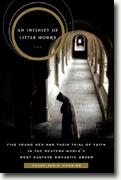An Infinity of Little Hours
Nancy Klein Maguire
book reviews:
· general fiction
· chick lit/romance
· sci-fi/fantasy
· graphic novels
· nonfiction
· audio books
· author interviews
· children's books @
curledupkids.com
· DVD reviews @
curledupdvd.com
newsletter
win books
buy online
links
home
for authors
& publishers
for reviewers

 |
An Infinity of Little Hours: The Trial of Faith of Five Young Men in the Western World's Most Austere Monastic Order Nancy Klein Maguire PublicAffairs Hardcover 258 pages February 2006 |
|
This reviewer is a Benedictine monk, and the subject of this review - An Infinity of Little Hours by Nancy Klein Maguire - is about five men attempting to become Carthusian monks in the early 1960s.
Maguire’s book is about the Carthusian monastery in England at Parkminster, West Sussex, which is under the patronage of St. Hugh, a Carthusian who became bishop of Lincoln, England. Maguire relates some of the founding history of the Carthusians and then moves to the history of the Carthusians in England. Some Carthusians during the time of King Henry VIII would not acknowledge that he was head of the Church in England. They were considered traitors and executed for this, as were St. Thomas More and St. John Fisher. When Catholicism was tolerated officially once again in England, the Carthusians were invited back to England to set up a charterhouse – their term for a monastery. The founders of this charterhouse eventually built one of the largest in the world. The Carthusians at that point in history (as today) had a group of lay brothers who acted as caretakers - fixing the food, meeting with guests or visitors, and taking care of other needs of the hermits. But the number of monks belonging to a charterhouse were (and remain) few - usually only ten to fifteen full members in each community. There were also men wanting to become Carthusians called postulants; they would later become novices if the finally professed monks allowed it. The novices eventually became juniors who, after three years, asked to become full members of the community and to profess solemn vows. Maguire goes deeply into these details, which may seem overly technical to those who do not live or understand the monastic life. Maguire was allowed to visit the charterhouse and spend time there, something that probably would not have happened in the old days before Vatican II. She gathered information about five men who tried – and one who perservered - to become hermits at that charterhouse. That rate of completion will not surprise the reader after finishing An Infinity of Little Hours. The Carthusian life at that time, as the subtitle says, was the Western world’s “most austere monastic order.” From interviews, photos and research, Maguire creates a personalized narrative of the Carthusian experience that is a pleasure to read. She describes the simple individual cells of the hermits - they have an oratory, a bed, a work room, and a garden. The monks pray together parts of the Divine Office or the Liturgy of the Hours. Some of their Office, though, is done in their cells. The charterhouse includes a huge library for the monks, a large dining room called a refectory, and other necessary buildings and rooms. Nancy Klein Maguire is the author of Regicide and Restoration: English Tragicomedy 1660-1671 (1992) and the editor of Renaissance Tragicomedy (1987). She is also the author of numerous publications on the relationship of theater and politics in the seventeenth century. She is a reviewer for the Los Angeles Times Book Review and has been a scholar-in-residence at the Folger Shakespeare Library since 1983. This book will fascinate anyone interested in monastic life and especially in the Carthusian way of monasticism. Highly recommended. Originally published on Curled Up With A Good Book at www.curledup.com. © Br. Benet Exton, O.S.B., 2006 |
|
|
|
 Click here to learn more about this month's sponsor! |
|
| fiction · sf/f · comic books · nonfiction · audio newsletter · free book contest · buy books online review index · links · · authors & publishers reviewers |
|
| site by ELBO Computing Resources, Inc. | |
 The Carthusians were founded around 1048 by St. Bruno, who wanted to create an eremitical (hermit) way of monasticism based on the Rule of St. Benedict and some other rules he and his successors would add to adapt the Rule of St. Benedict to this way of life. St. Bruno founded his first hermitage in France in the Alps; Grande Chartreuse, the name of this first foundation, is where the term “Carthusian” comes from. The Carthusians had the reputation of being the only Order not reformed liked the Benedictines and Cistercians, although they were somewhat reformed with the Second Vatican Council (1962-1965). There is only one Carthusian monastery in the United States that this reviewer is aware of, in Vermont. The Carthusians are not a large order compared to the Benedictines or Trappists, and they are known to be quite strict and require psychological stability.
The Carthusians were founded around 1048 by St. Bruno, who wanted to create an eremitical (hermit) way of monasticism based on the Rule of St. Benedict and some other rules he and his successors would add to adapt the Rule of St. Benedict to this way of life. St. Bruno founded his first hermitage in France in the Alps; Grande Chartreuse, the name of this first foundation, is where the term “Carthusian” comes from. The Carthusians had the reputation of being the only Order not reformed liked the Benedictines and Cistercians, although they were somewhat reformed with the Second Vatican Council (1962-1965). There is only one Carthusian monastery in the United States that this reviewer is aware of, in Vermont. The Carthusians are not a large order compared to the Benedictines or Trappists, and they are known to be quite strict and require psychological stability.